Searching for a foreground plant for your nano tanks can be a daunting task if you are a beginner. This is where waterwort (Elatine Hydropiper) will be your savior.
It is a micro plant that is easy to maintain and creates an appealing carpet in your aquarium. Since the plant itself is so small, it doesn’t take much more than a few-inch layer of your tank.
In this guide, you’ll learn everything you need to know about Elatine Hydropiper Care in your aquarium.
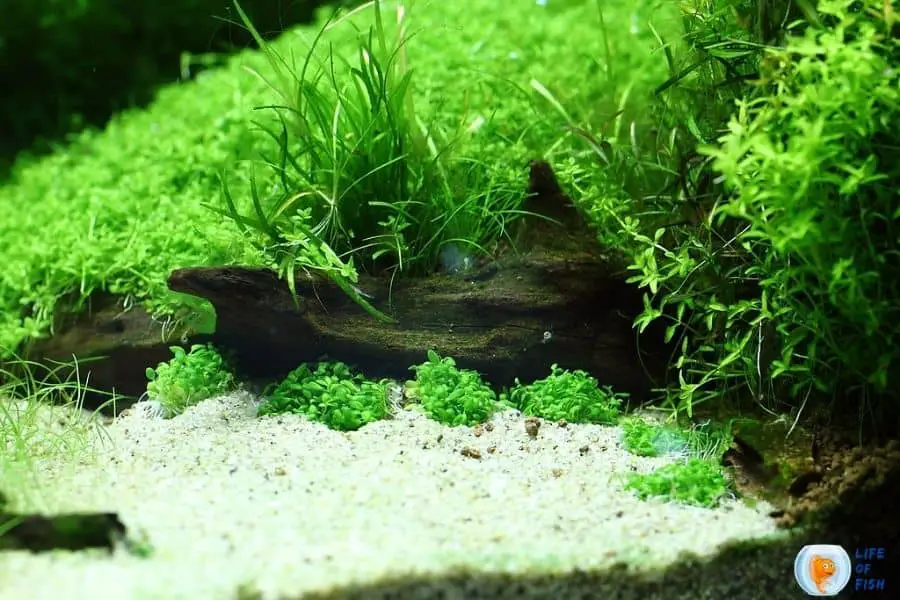
What is Elatine hydropiper?
Jump To
- 1 What is Elatine hydropiper?
- 2 What’s great about Elatine Hydropiper?
- 3 How to identify?
- 4 Is Elatine hydropiper easy to grow?
- 5 Distribution & Natural Habitat
- 6 One Look Care Guide
- 7 Aquarium Care requirements
- 8 How to keep Elatine hydropiper alive
- 9 Elatine hydropiper Tankmates
- 10 Diseases and Common Problems, treatment
- 11 How to attach Elatine hydropiper
- 12 Final thoughts
These aquatic plants, also known as eight-stamen waterwort. It is a small plant from the Elatinaceae family.
The “Elatine” genus is a group of aquatic plants, with only 25 species included in the Elatine hydropiper.
Hailing from Europe Northern China and East Asia, this plant was first introduced as an aquarium plant in 2010.
Fast-growing carpeting plants were a problem for many aquarists until 2010, as they required frequent trimming. Therefore, soon after introducing this plant, it hit the market like fire.
It is best to place These aquarium plants in the foreground, as it has tiny leaves with a creeping growth.
Elatine hydropiper grows similarly to Hemianthus callitrichoides ‘Cuba’ and Glossostigma elatinoides, but it develops more slowly, making it simpler to maintain.
What’s great about Elatine Hydropiper?
With Elatine Hydropiper, you can make your nano tanks look like an oasis in desert sand by creating a lush green cover over your substrate with little effort.
These aquarium plants also spreads by sending out runners under the substrate.
All you need to do is plant Elatine Hydropiper in a small layer of gravel, and it will spread throughout your tank, with no further effort required from your part.
How to identify?
Several plants look like Elatine Hydropiper, so many aquarists often pick the wrong carpeting plant, confused with this plant.
However, there are some physical characteristics that Elatine Hydropiper has which make it easy to distinguish from its lookalikes.
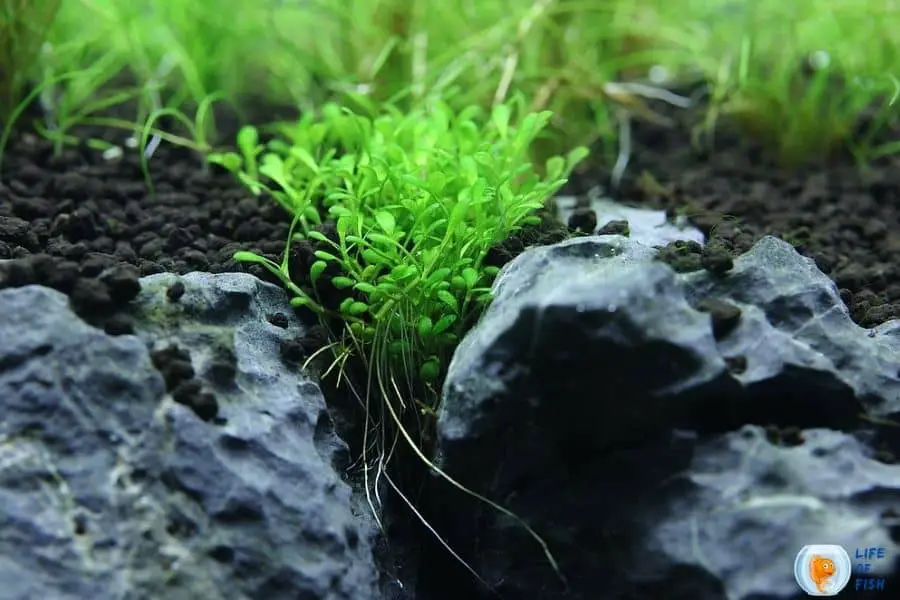
Stem
Aquarium plants have a soft stem that turns whitish when buried in the soil but greenish in water.
Leaves
This plant has small, Whorled and Elliptic leaves that stay closer to the substrate.
Flowers
This plant produces tiny pink flowers with 3 to 4 thin, transparent petals. The flowers flourish in each leaf axil, making a beautiful pink carpet look.
When the plant is submerged, the color of these flowers changes to white.
I can say waterwort (Elatine hydropiper) looks like miniature version of Glossostigma elatinoides.
Is Elatine hydropiper easy to grow?
Like most plants these aquarium plants are relatively easy to care for.
It doesn’t need regular maintenance like other carpeting plants but demands high lights, cool, soft water, and CO2 injection for proper growth.
While this can be challenging for beginners, it is an excellent plant for those who want to make their nano tanks appealing.
After all, providing these conditions is not difficult if you use proper equipment in your aquarium.
Distribution & Natural Habitat
Aquarium plants are native to Europe northern China and East Asia. Elatine Hydropiper is a plant that loves cold water, and it grows in ponds, rivers, and marshes.
One Look Care Guide
| Scientific name | Elatine Hydropiper |
| Common name | eight-stamen waterwort |
| Care level | Moderate |
| Native to | Europe and East Asia |
| Type | Freshwater plant |
| Placement | Foreground, Ground cover |
| Color | Fresh green colour |
| Tank size | Suitable for Nano aquariums, any |
| Preferred temperature | 4 – 26°C |
| Other water parameters (ammonia ,ect) | pH level: 4-8Hardness: 4 – 8°dKH, 0 – 30°dGH |
| Preferred salinity | No salinity |
| Size | 1-2 inches in height |
| Growth rate | slow |
| Recommended tank mates | Any species |
| Propagation | Runners, Splitting, Cuttings, cutting off daughter plants |
Aquarium Care requirements
Caring for Elatine Hydropiper is straightforward; however, you must keep Elatine Hydropiper in the right conditions to see them flourish.
Lighting
Aquarium plants prefer intense lighting, so you need to keep Elatine hydropiper in intense light.
Elatine Hydropiper will not grow properly without good lighting, and under weak lighting conditions, it may bloom poorly or even die off entirely.
The average light it requires is 0.5 watts per liter.
Fertilizers & Substrates
Aquarium plants do not require fertilizers to thrive. It can grow on any substrate. We recommend adding gravel substrate because this plant can easily spread its roots around the gravel.
Can this aquatic plants grow on sand?
Yes. This plant can grow on sand without any problem.
Water quality
Elatine Hydropiper thrives best when kept at a pH level of between 4 and 8 and carbonate hardness of between 4 and 8°dKH.
The general hardness should be around 0 to 30°dGH, and most importantly, the water should be cold.
Temperature
Aquarium plants do not like high temperatures; Elatin Hydropiper prefers cooler water (4 – 26°C).
Elatine hydropiper will not show its best colors in high temperatures and tend to die in temperate water conditions.
Placement
This plant is an excellent choice as a foreground plant of any size nano tanks. Elatine hydropiper is a plant that spreads, and it can be used as ground cover in shallow tanks.
Elatine Hydropiper will grow towards the front of your nano tanks, so you need to keep Elatin Hydropipers around 15cm from the edge of your tank.
Can you float this aquarium plant
You can not float Elatine hydropiper because they can not grow out of the substrate. They mostly use as carpet plant. Therefore, we use this plant as an ultimate floor plant.
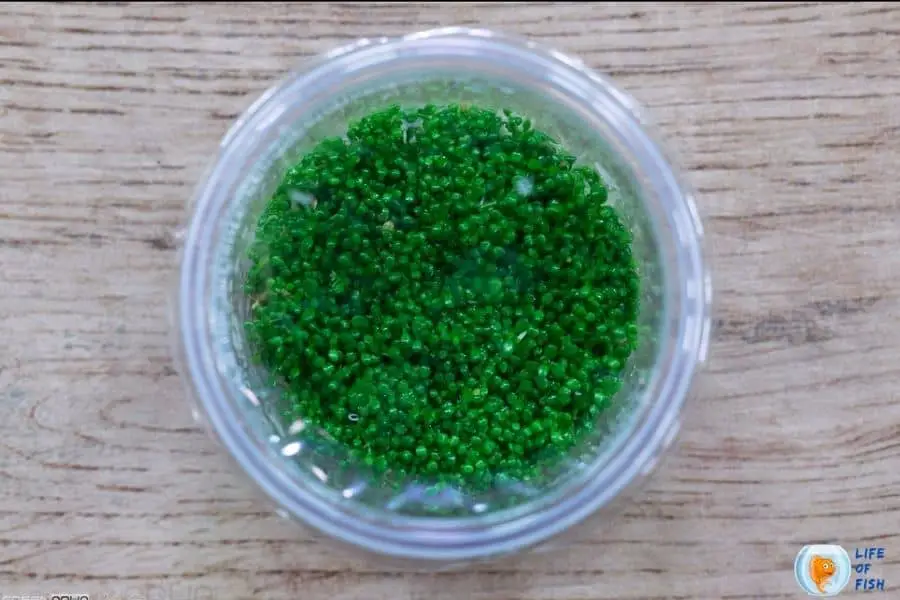
How to keep Elatine hydropiper alive
Keeping Elatine hydropiper in an aquarium is relatively easy if you own the proper equipment in your tank.
Once you set up your tank accordingly, the plant will grow itself without any maintenance.
How fast does Elatine hydropiper grow
Waterwort (Elatine hydropiper) has a medium growth rate compared to other carpet plants.
Because of this, the amount of pruning Elatine hydropiper requires is not high.
Elatine Hydropiper grows over the gravel and spreads its roots around, so you need to remove parts of this plant from time to time if you want a part of your substrate exposed.
How to trim Elatine hydropiper
Since this is a moderately slow-growing plant, regular maintenance is not necessary. It will take some time for this plant to grow out of control.
When this happens, you will have to control the growth by trimming it. You can easily prune this plant with a pair of scissors.
As this is a beautiful carpet plant, you will find that trimming and styling process to be so relaxing. So, we bet you’ll fall in love with this plant if given proper care.
Does Elatine hydropiper need CO2
CO2 is one of the main requirements for Elatin Hydropipers to thrive. If you want this plant to thrive and prosper, CO2 injection is essential.
Otherwise, this plant will rapidly turn yellow or wither. However, you can easily inject CO2 using a pressurized CO2 setup or a DIY kit.
There are plenty of tutorials on setting up a CO2 injection system on Youtube.
How do you propagate Elatine hydropiper?
Propagating this plant is pretty straightforward. You can propagate Elatin Hydropipers from Runners, Cuttings, Splitting, and cutting off daughter plants.
Either way, this plant will start to grow again if it receives proper care.
However, before you get to propagate, you will first have to grow the plant in your aquarium.
For that, you will have to buy a tissue culture cup from the aquarium shop. The plant in this cup is not the regular type plant you will see in the aquarium.
The tissue culture plant (cup) is propagated in a laboratory in vitro-style to ensure that the plant is pest-free for the customer.
After you’ve collected the tissue culture plant, remove them from the cup as soon as possible. Then wash out the liquid or gel they’re planted in.
After removing the wax, massage the roots lightly. This will ensure that all of the gel has disappeared from the roots.
You may now distribute the plant throughout your aquarium as directed if you allow the roots to be free.
After several days, the plant will start to grow, multiplying. Once the plant establishes in the tank, you can start propagating this plant.
Can Elatine hydropiper grow out of water?
Elatine hydropiper is an exclusive foreground plant that needs a substrate to grow. Therefore, this plant can not grow out of water.
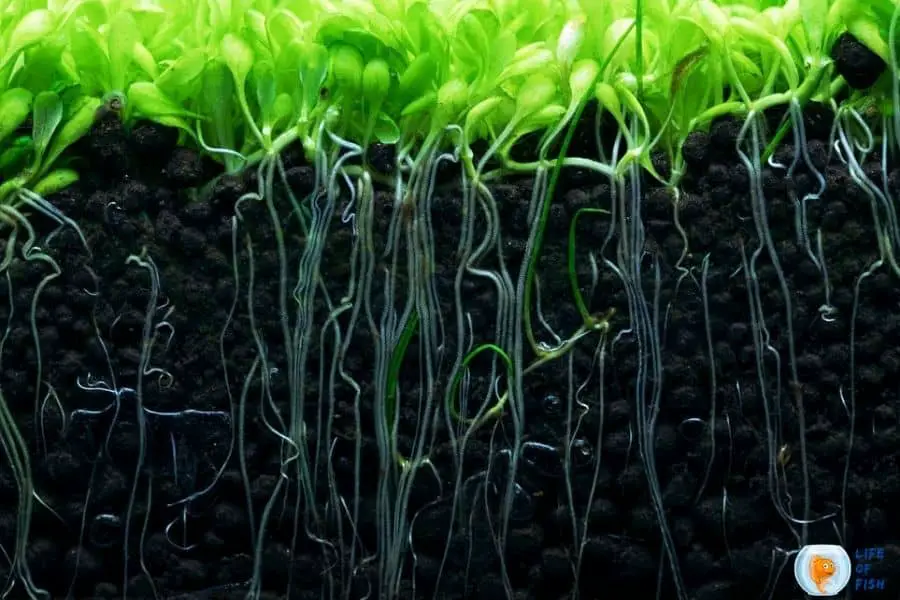
Elatine hydropiper Tankmates
Elatine Hydropiper likes bright lighting, so it’s best suited for nano tanks with intense lightings. Therefore, the tankmates should be able to live in such conditions.
Fish
Since this plant is widely sold as tissue cups to ensure no pests in the plant, Elatine hydropiper carries no risk to the fish in your aquarium.
As this is a foreground carpet plant, most fish do not bother with this plant. However, some fish do.
Elatine Hydropiper can be combined with almost any other fish species because Elatinaceae does not contain any allelochemicals.
Elatinaceae is not toxic if the fish consume it, so that you can combine Elatine hydropiper with any species of fish.
However, the fish should be able to tolerate high light conditions as this plant requires it.
Other Plants
You can combine this plant with any midground or background plant, but be sure to set up your tank to provide most of the light to this plant.
The midground and background plants should not cover up the lighting to this plant.
Snails and shrimp
Elatine Hydropiper leaves are soft by themselves, but Elatine Hydropipers‘ roots are pretty tough. So, snails and shrimp can easily damage Elatin Hydroppier’s leaves by chewing on them.
However, you should not worry about Elatin Hydroppier too much as this plant is more resilient than other carpet plants like Micranthemum Monte Carlo or Glossostigma Elatinoides.
Elatine Hydroppier is relatively easy to grow and can handle a lot of abuse from snails and shrimp, but you should still keep it away from your invertebrates as much as possible.
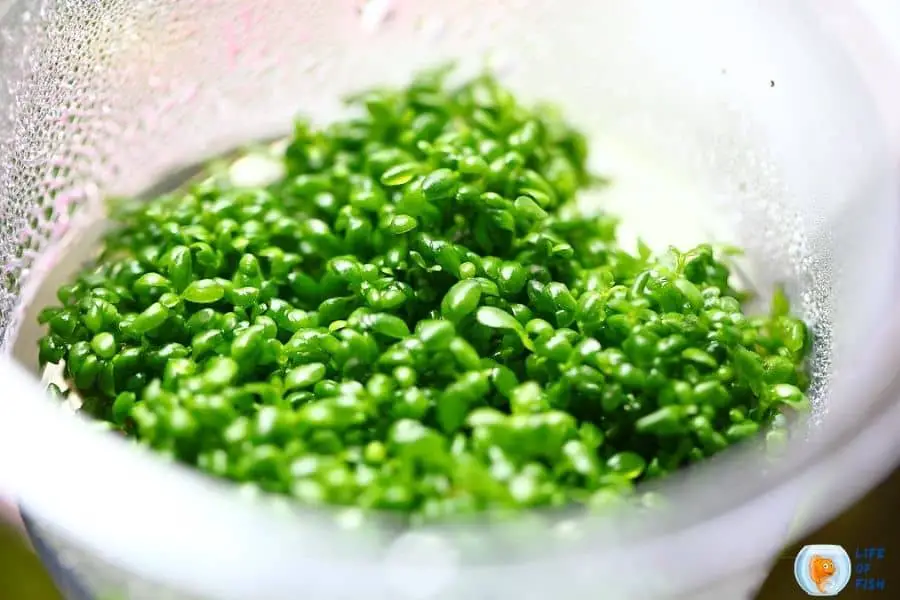
Diseases and Common Problems, treatment
Elatine hydropiper is a resilient plant with very few diseases and common problems.
Elatine hydropiper can handle a lot of abuse from snails, shrimp, and other species in your aquarium as long as you give them enough light and nutrients to grow properly.
However, the plant’s leaves will burn if the lighting is too intense or not intense enough for this plant. Elatine Hydropipers’ leaves will also burn if the CO₂ concentration is too low.
Elatine Hydropiper can not tolerate less than 40 ppm carbon dioxide, so you should be careful when adding Elatine hydropiper to an aquarium with lowered CO₂ levels.
The poor water circulation will also cause the leaves to burn.
The symptoms and signs of burning leaves of this plant are yellowing of the leaves and developing small round holes in the leaves.
Treatment- Look for the underlying cause for burning leaves. If you don’t provide enough CO2, start providing CO2.
Install an air stone, water filter, or water pump if the water in your tank doesn’t move. Check for the lighting and change accordingly.
How to attach Elatine hydropiper
You can only plant this plant on a substrate because it needs a substrate to establish its root system. Therefore, you can not attach this plant to driftwood, rocks, plastic, or fabric.
Final thoughts
Elatine Hydropiper is a high demanding plant that requires intense lighting, colder water, and CO2.
If given proper water conditions and care, this plant will grow without many hassles and need low maintenance by your side.
It may seem like this plant is hard to grow, while actually, it is not. When given proper care, it will make the bottom of your aquarium look beautiful and green.
Read Next: Ludwigia Glandulosa Ultimate Care Guide | 11 Important Facts|
